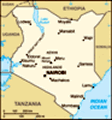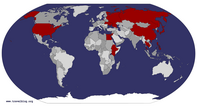Advertisement
Published: February 27th 2009
Considering that we are a hundred miles from the nearest wide spot in the road, I think the technology here is pretty nifty.
First, let’s start with the basics - water and sewer. Water comes from mountain springs or wells and is collected in a concrete reservoir just uphill from the dispensary. You might call it the water tower, but it’s not a tower, so you probably shouldn’t. It is then piped down to the home(s) and a spigot in the middle of the truck yard as well as a faucet in the town of Arsim. Water for consumption by Americans needs to be boiled and filtered to not upset our delicate constitutions. Drinking directly from the tap would result in the Kenyan version of Montezuma’s Revenge. By the way, did you know that if Mexicans drink US tap water they can also get gastric distress? Do you suppose that should be called Bush’s Revenge?
There’s a new water system just about ready to go. However, the final piping has not been complete and there is a dispute over money with the contractor. In the meantime, the pipes lay on the ground up the hill, and the valves and
other fittings are left lying in the carport between the two missionary houses. Someday the dispute will be resolved and there will be running water in the dispensary, clinic, maternity ward - who knows where else?
Water for medical purposes like eye surgery needs to be purchased as distilled water. Gloria has recently purchased a filtration system that will remove the impurities to the point that the finished product is suitable for use in surgery. We (does that mean me?) still need to get the filter installed so that it can be used effectively.
The filtration system in our house is of a similar type so that we can just fill up the bucket on top with tap water and the filtered water can drip into a bottle for drinking. The system in Gloria’s house still requires her to boil the water and then filter the impurities out before putting it into bottles for drinking, etc. Every couple of months, the ceramic filters in the upper chamber need to be removed and scrubbed to remove the accumulation of rust and calcium that gets filtered out. I had the pleasure of scrubbing her filters the other day. She gave
me a brush that contains hard bristles made of plastic. She’s used it so hard that about 95% of the surface bristles are missing and the remaining 5% are so worn down that they’re hardly useful.
When I suggested we buy her a new brush once we get to Nairobi next week, she replied, ”Well, I don’t like to waste anything.” Don’t tell her, but I think we’ll buy her a new filtration system once we get to Nairobi.
The water that flows into the two missionary houses is plumbed for both hot and cold. However, in order to save money at the time the houses were built, the hot water side was never hooked up. It’s all ready to go, just waiting for the money and the need. In the week or so that we’ve been here, we really haven’t needed hot water. The cool water in the shower is actually pretty refreshing.
Sewage seems to be piped out of our house into some sort of a collector box and then goes down to a large sediment tank with a sand bottom. Since it only rains here about two weeks out of every year and that

 Batteries
Batteries
these oughta get yer car started in the winter in Kenyais in a single continuous stretch, there’s really no ground water to speak of at this elevation which could be contaminated. I’m sure it’s more scientific than that, but I’m going to worry my pretty little head over it.
Electricity is pretty well figured out. All the buildings in the Dispensary compound have solar collectors and there is quite an array of storage batteries in the office building. That electrical system gets turned off every evening as the staff goes home. There is a separate small building that houses a diesel-powered generator. Gloria tells me that it has only been used twice so far. However, once the maternity building is up and running and the eye surgery theater is operational, the equipment in them will require more power than the solar system can deliver. In the meantime, solar power is far less expensive to run (can you say “free”?) and runs the lights and computers just fine.
Of course, the electricity is 240 volts 50 cycles (sorry, that’s old school - Hertz) which is different from the 110 volts 60 cycles we have in the US. Most European and many Asian and African countries use a type of plug that is two circular prongs about an inch and a half apart. Kenya is a former British colony so the type of plug used here is the British style of 3 rectangular posts of two different sizes and the whole apparatus is about twice the size of a US 3-prong plug. Fortunately, in our pre-trip research we were aware of the differences and have brought along adapters for every size and shape known to humankind. The appliances we brought along all work on anything from 100 volts (Japan) to 240 volts (Kenya) and everything in between (the other 11 countries we visit on this trip).
However, here at the Arsim Dispensary, the solar power and backup batteries are not strong enough to power heat-producing appliances. Therefore, Cheryl is relegated to alternate hair styles that do not require her hair dryer or curling iron. I’m kind of starting to like her in pigtails and with her hair “up” in back.
Also in the same room is a modem for the satellite internet connection and it’s tied into a wireless router that reaches the single building. When it’s on, the connection is quite reliable, albeit slow by DSL/Cable standards. I suspect that the wireless network is faster that the internet link. We tried connecting via Skype to our church service on Sunday and found that we were short of bandwidth so that the voice only connection worked fine, but video was out of the question. I also tried our MagicJack connection for voice calls to the US and Canada, but was again unable to make a useable connection.
The MagicJack is a wonderful little device that once plugged into the computer allows us to make phone calls to any number in the US or Canada for free! Er, that is as long as we have a high-speed internet connection. Unfortunately, the connection here is not fast enough to handle the MagicJack requirements. We’ll see how well it operates once we get back to Nairobi and onward with our trip. Last fall we were able to use it to call grandkiddies and others successfully from Italy, Greece and Bulgaria. We’ll see.
Transportation for the dispensary consists of four what Gloria calls “cars” and four motorcycles. The cars are all actually Toyota Land Cruiser 4 X 4’s they are in various stages of newness and reliability. I’ve already shown you a picture of the one labeled “Ambulance” the others also have sirens and a flashing light on top, but in the week we’ve been here I haven’t seen or heard any of them in use. All are diesel powered for consistency and reliability.
The motorcycles are useful for traveling to the bush country for delivery of small packages and messages. For example, there are about 2,000 people in Greater Arsim. Arsim, itself is home to about 600-800 people while the “suburbs” encompass an area of about 2 kilometers (1.25 miles) around and included the surrounding mountains and the settlements on the other side of the mountains. Traveling to a settlement just 800 meters (one-half mile) over the mountain may require a road distance of 10 kilometers (6 miles). Motorcycles are much more efficient for reaching those settlements than either the “cars” or on foot.
Peter, our driver the day we arrived from Nairobi, is actually the dispensary master mechanic. He keeps everything in running order. His shop would be the envy of all my mechanically inclined friends. It’s dirty, greasy, grimy and seemingly unorganized. He can find anything in an instant. It has tools both power and hand, welders (acetylene & arc) lifts, jacks, shelves of Toyota Land Cruiser spare parts, tire repair stuff - what more could a man want?
The landing strip that services Arsim is at Korr. It was a 2-hour drive with our expert, Peter, at the wheel and would be about 3 hours with anyone else driving. Korr is a Rendille town and the site of a Roman Catholic Mission. The people here, at MAF in Nairobi and even on maps refer to it alternately by name or as “Catholic” The Catholic church built the landing strip there many years ago. There’s no tower, no air traffic control, no lights, no hanger, no facilities. In a busy week they may see up to four aircraft land and take off again.
A landing strip is being built just on the outskirts of Arsim. The land has been about 60% cleared of vegetation, by hand. Anyone who wants to work hard at pulling scrub brush can do so and is paid 300 Kenyan Shillings (under $4 US) per day. A road grader is scheduled to be brought in to smooth out what is euphemistically called a road sometime next April (or was that last April?). The contractor has agreed to run his grader over the landing strip to make it suitable for one barrel of diesel fuel. If he has to bring the grader for just that purpose, the price would be K sh 400,000 (over $5,000 US).
The new landing strip will make delivery of goods from Nairobi much more practical. It will also be instrumental in transporting seriously ill patients to more complete medical facilities. I mentioned Julia Harrington back in Nairobi. She would love come to Arsim and help out with administrative matters for a year or so while a local staff member is at university. However, she has a back condition that requires her to have access to emergency treatment if her condition worsens. The new landing strip would allow her to come.
Advertisement
Tot: 0.079s; Tpl: 0.012s; cc: 9; qc: 48; dbt: 0.0472s; 1; m:domysql w:travelblog (10.17.0.13); sld: 1;
; mem: 1.2mb









